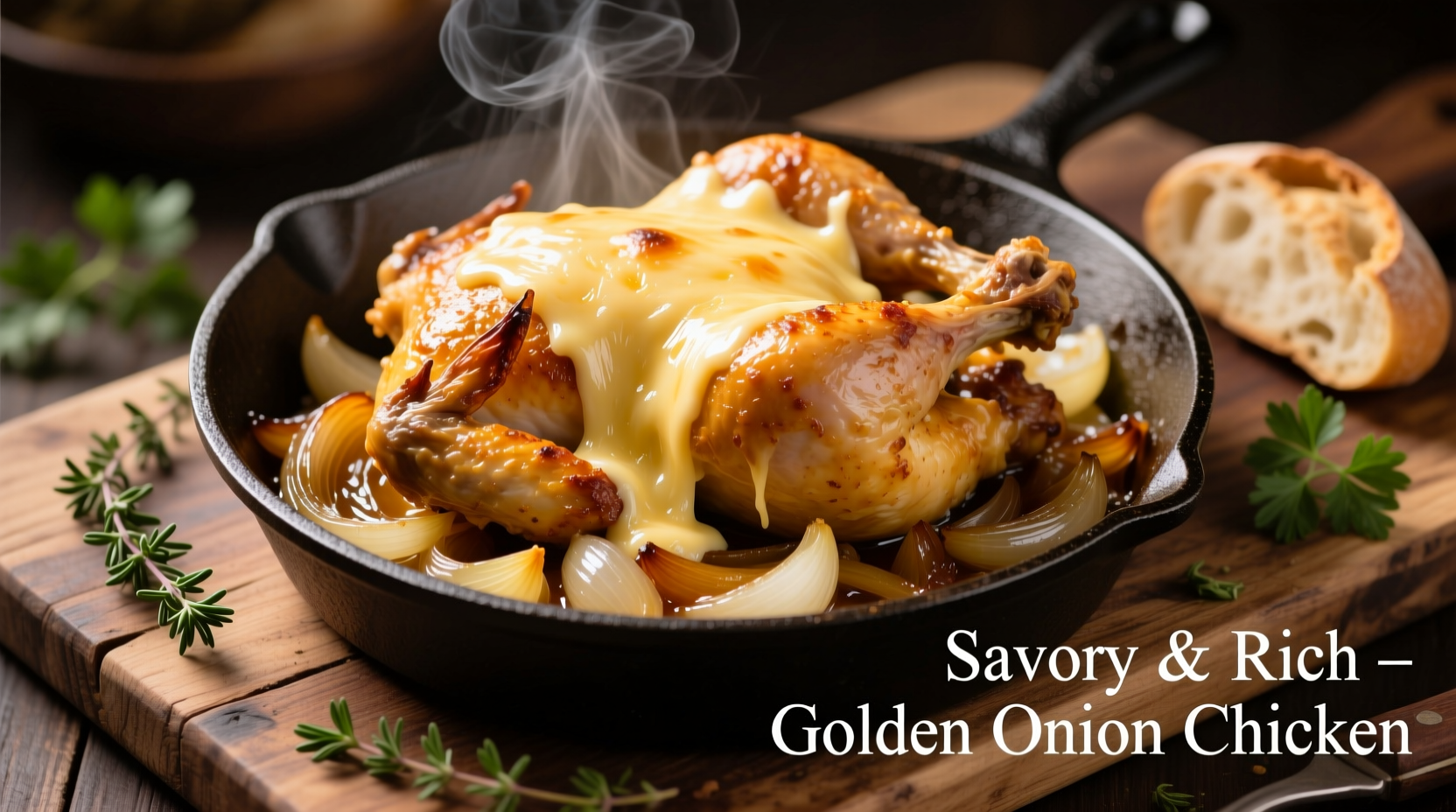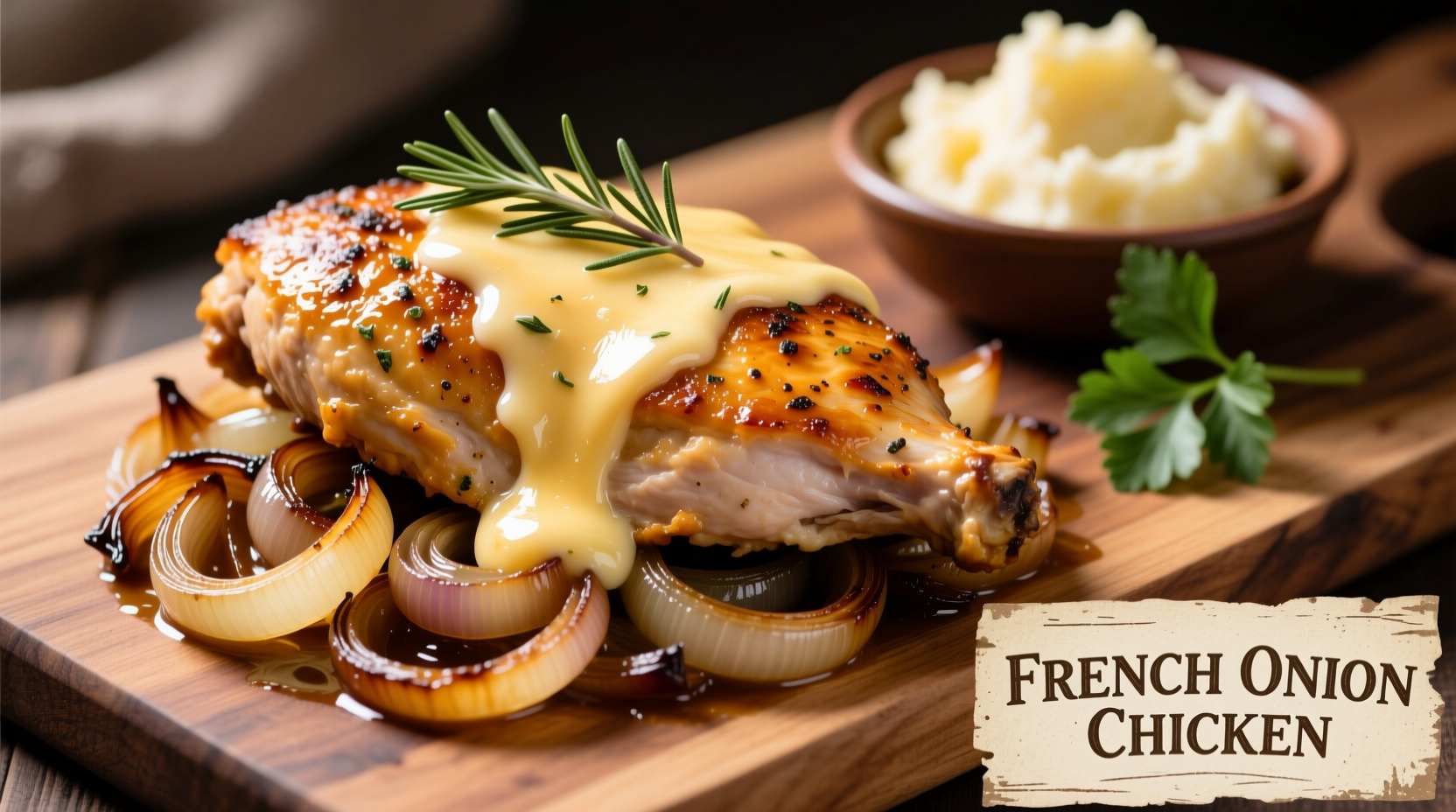What Makes French Onion Chicken Special
French onion chicken transforms the classic French onion soup into a satisfying main course by pairing tender chicken with deeply caramelized onions and rich broth. Unlike its soup counterpart, this dish balances protein and savory-sweet elements for a complete meal that feels both rustic and elegant. Home cooks searching for easy French onion chicken recipe options often struggle with common pitfalls like bitter onions or rubbery cheese—but our tested method solves these issues.
Historical Evolution of French Onion Dishes
French onion preparations have evolved significantly since their 18th century origins. Understanding this timeline helps appreciate modern adaptations:
| Era | Key Development | Modern Relevance |
|---|---|---|
| 1700s | French onion soup created as peasant food using stale bread and onions | Foundation for all onion-based French dishes |
| 1950s | American chefs added melted cheese and broiled topping | Inspired today's cheesy variations |
| 1980s | Chefs began incorporating proteins like chicken and beef | Birth of French onion chicken as we know it |
| 2010s-Present | Home cooking adaptations simplified restaurant techniques | Accessible how to make French onion chicken from scratch methods |
Essential Ingredients Breakdown
Quality ingredients make the difference between good and exceptional French onion chicken. Don't compromise on these elements when following any authentic French onion chicken ingredients list:
- Onions: Use 3-4 large yellow onions (about 2 lbs). Their natural sugar content creates perfect caramelization.
- Chicken: Boneless, skin-on thighs provide more flavor and stay juicier than breasts during cooking.
- Cheese: Gruyère remains the gold standard, but Comté offers a more affordable alternative with similar melting properties.
- Broth: Homemade chicken stock elevates the dish, but low-sodium store-bought works with added umami boosters.

Step-by-Step Cooking Process
Follow this professional technique for foolproof results every time you attempt French onion chicken cooking time sensitive preparation:
Phase 1: Perfect Onion Caramelization (45-60 minutes)
- Slice onions uniformly using a mandoline for consistent cooking
- Cook over medium-low heat with butter and oil (prevents burning)
- Add pinch of sugar after 20 minutes to accelerate browning
- Stir in 1 tbsp all-purpose flour after caramelization for thickening
Phase 2: Chicken Preparation (20 minutes)
- Season chicken thighs generously with salt and pepper
- Sear skin-side down in separate pan until golden (8 minutes)
- Flip and cook 5 minutes until nearly done
- Place on top of caramelized onions in oven-safe dish
Phase 3: Broiling Finish (8-10 minutes)
- Pour hot broth over chicken and onions
- Top with 1 cup shredded cheese (see comparison table below)
- Broil until cheese bubbles and develops golden spots
- Rest 5 minutes before serving for optimal texture
Cheese Selection Guide
Choosing the right cheese dramatically impacts your best cheese for French onion chicken results. This comparison helps avoid common melting disasters:
| Cheese Type | Melting Quality | Flavor Profile | Best For |
|---|---|---|---|
| Gruyère | Excellent, smooth melt | Nutty, slightly sweet | Traditional preparation |
| Comté | Very good melt | Buttery, complex | Budget-friendly alternative |
| Emmental | Good stretch | Mild, subtle | Beginner cooks |
| Mozzarella | Poor, becomes rubbery | Neutral | Avoid in this dish |
Common Mistakes to Avoid
Even experienced cooks make these errors when preparing French onion chicken:
- Rushing onion caramelization: Turning heat too high creates bitter onions instead of sweet, golden ones
- Using pre-shredded cheese: Anti-caking agents prevent proper melting—always shred your own
- Overcrowding the pan: Causes steaming instead of searing chicken
- Serving immediately: Cutting too soon releases precious juices—always rest 5 minutes
When This Dish Works Best (Context Boundaries)
French onion chicken shines in specific situations but has limitations:
- Ideal for: Casual dinner parties, winter comfort meals, using leftover roasted chicken
- Not recommended: Quick weeknight dinners (requires 90+ minutes), strict low-sodium diets, lactose intolerance
- Special occasion adaptation: Use duck instead of chicken for elevated version
- Time-saving tip: Caramelize onions ahead and refrigerate for up to 3 days
Serving and Storage Tips
Maximize your French onion chicken experience with these professional recommendations:
- Serve in wide, shallow bowls to showcase the melted cheese topping
- Pair with crusty baguette for dipping and a simple green salad
- Store leftovers in airtight container for up to 3 days
- Reheat gently in oven at 325°F with splash of broth to prevent drying
- Freeze portions for up to 2 months (thaw overnight before reheating)











 浙公网安备
33010002000092号
浙公网安备
33010002000092号 浙B2-20120091-4
浙B2-20120091-4